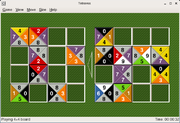
TetraVex
Encyclopedia

Microsoft Windows
Microsoft Windows is a series of operating systems produced by Microsoft.Microsoft introduced an operating environment named Windows on November 20, 1985 as an add-on to MS-DOS in response to the growing interest in graphical user interfaces . Microsoft Windows came to dominate the world's personal...
and Linux
Linux
Linux is a Unix-like computer operating system assembled under the model of free and open source software development and distribution. The defining component of any Linux system is the Linux kernel, an operating system kernel first released October 5, 1991 by Linus Torvalds...
systems.
Gameplay
TetraVex is an edge-matching puzzleEdge-matching puzzle
An edge-matching puzzle is a type of tiling puzzle involving tiling an area with polygons whose edges are distinguished with colours or patterns, in such a way that the edges of adjacent tiles match....
. The player is presented with a grid (by default, 3x3) and nine square tiles, each with a number on each edge. The objective of the game is to place the tiles in the grid in the proper position as fast as possible. Two tiles can only be placed next to each other if the numbers on adjacent faces match.
Availability
TetraVex was originally available for Windows in Windows Entertainment Pack 3. It was later re-released as part of the Best of Windows Entertainment PackBest of Windows Entertainment Pack
The Best of Windows Entertainment Pack was a collection of thirteen 16-bit simple games sold separately from Windows. It was published in the Microsoft Home series of software. They were selected as the best games from the previously released Microsoft Entertainment Pack series...
. It is also available as an open source game on the GNOME
GNOME
GNOME is a desktop environment and graphical user interface that runs on top of a computer operating system. It is composed entirely of free and open source software...
desktop.
Origins
The original version of TetraVex (for the Windows Entertainment Pack 3) was written (and named) by Scott Ferguson who was also the Development Lead and an architect of the first version of Visual Basic. TetraVex was inspired by "the problem of tiling the plane" as described by Donald KnuthDonald Knuth
Donald Ervin Knuth is a computer scientist and Professor Emeritus at Stanford University.He is the author of the seminal multi-volume work The Art of Computer Programming. Knuth has been called the "father" of the analysis of algorithms...
on page 382 of Volume 1: Fundamental Algorithms, the first book in his The Art of Computer Programming
The Art of Computer Programming
The Art of Computer Programming is a comprehensive monograph written by Donald Knuth that covers many kinds of programming algorithms and their analysis....
series.
In the TetraVex version for Windows, the Microsoft Blibbet logo is displayed if the player solves a 6 by 6 puzzle.
The tiles are also known as McMahon Squares, named for Percy McMahon
Percy Alexander MacMahon
Percy Alexander MacMahon was a mathematician, especially noted in connection with the partitions of numbers and enumerative combinatorics.-Early life:...
who explored their possibilities in the 1920s.
Counting the possible number of TetraVex
Since the game is simple in its definition, it is easy to count how many possible TetraVex are for each grid of size . For instance, if
. For instance, if  , there are
, there are  possible squares with a number from zero to nine on each edge. Therefore for
possible squares with a number from zero to nine on each edge. Therefore for  there are
there are  possible TetraVex puzzles.
possible TetraVex puzzles.Proposition: There are
 possible TetraVex in a grid of size
possible TetraVex in a grid of size  .
.Proof sketch: For
 this is true. We can proceed with mathematical induction.
this is true. We can proceed with mathematical induction.Take a grid of
 . The first
. The first  rows and the first
rows and the first  columns form a grid of
columns form a grid of  and by the hypothesis of induction, there are
and by the hypothesis of induction, there are  possible TetraVex on that subgrid. Now, for each possible TetraVex on the subgrid, we can choose
possible TetraVex on that subgrid. Now, for each possible TetraVex on the subgrid, we can choose  squares to be placed in the position
squares to be placed in the position  of the grid (first row, last column), because only one side is determined. Once this square is chosen, there are
of the grid (first row, last column), because only one side is determined. Once this square is chosen, there are  squares available to be placed in the position
squares available to be placed in the position  , and fixing that square we have
, and fixing that square we have  possibilities for the square on position
possibilities for the square on position  . We can go on until the square on position
. We can go on until the square on position  is fixed.
is fixed.The same is true for the last row: there are
 possibilities for the square on the first column and last row, and
possibilities for the square on the first column and last row, and  for all the other.
for all the other.This gives us
 .
.Then the proposition is proven by induction.

It is easy to see that if the edges of the squares are allowed to take
 possible numbers, then there are
possible numbers, then there are  possible TetraVex puzzles.
possible TetraVex puzzles.

